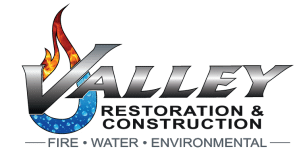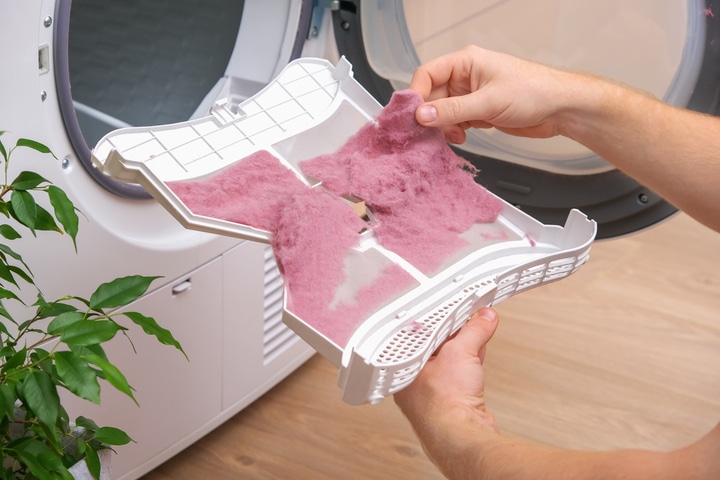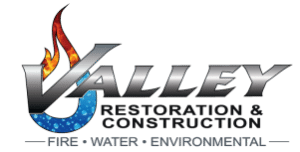Although most people assume lint buildup isn’t a big deal, it can actually cause catastrophic results within your home. According to Consumer Reports, over 13,000 home fires are caused by clothes dryers each year [1]. Furthermore, over ¼ of these fires are the direct result of lint accumulation.
The team at Valley Restoration & Construction knows from firsthand experience how devastating dryer fires can be. Therefore, we want to help you ensure dryer safety within your home by explaining the contributing factors to dryer fires and what you can do to prevent dryer vent fires in your home.
Dryer Fire Statistics
Dryer lint build-up can lead to a dangerous situation, not just decreased dryer performance. Ignoring proper maintenance increases the potential for a devastating dryer lint fire.
Dryer lint fires occur more frequently than you might realize. As we previously mentioned, clothes dryers cause approximately 13,800 fires annually, and 27 percent of these fires are due to lint build-up [1].
In addition, homeowners pay around $200 million in property damage yearly due to dryer fires [2]. The frequency and damage of these fires highlight the urgent need for homeowners to address this overlooked aspect of fire prevention.
Causes of Dryer Fires
Dryer fires result from a number of causes. However, most of these potential threats can be avoided if you know what you’re looking for. Proactive measures, informed by awareness, effectively mitigate household fire hazards.
Below are some of the most common causes of dryer fires.
Lint Build-Up
When people ask, “Can dryer lint cause a fire?” the answer is always yes. The accumulation of lint is a common cause of dryer fires. Generally, lint build-up happens when a person forgets to clean out the lint trap of their dryer regularly. As dryers accumulate lint, airflow restriction occurs, which is evident when clothes take longer to dry.
Over time, lint can accumulate in ducts, forming a flammable layer and increasing temperature. This heightened temperature poses a severe risk of fires, as it may compromise the proper functioning of the high-limit thermostat. The high-limit thermostat is a crucial safety feature that shuts off the heating element to prevent extreme temperatures.
Lint build-up becomes a time bomb, as dryer lint fires can erupt with the slightest spark.
Clogged Dryer Ducts
Clogged dryer ducts present a critical safety concern in households due to the alarming risk of dryer lint fires. Debris, lint, dust, and small pocket items can cause clogs. Clogged dryer ducts are likely to cause clothes dryer fires, regardless of the substance.
Neglected maintenance amplifies the dangers, as the accumulated materials become highly flammable, resulting in catastrophic fire incidents. This destruction can lead to financial losses and jeopardize the safety of occupants. It’s crucial to regularly clean dryer traps and ducts to prevent potential clothes dryer fires.
Inadequate Ventilation
An issue with the dryer vent exhaust might drive clothes that take too long to dry or feel hotter than usual. Inadequate dryer ventilation poses severe risks, contributing to potential clothes dryer fires.
When the exhaust installation points indoors, it can cause dryer vent fires. Poorly done dryer vent installations can also cause indoor air deterioration and mold build-up. Optimal dryer ventilation is crucial, reducing fire risk by ensuring proper airflow.
Overloading
Overloaded clothes dryers are a significant contributor to clothes dryer fires. When users stuff their dryer with excessive clothing or bedding materials, it hinders the proper circulation of air within the dryer. This obstruction impedes the appliance’s ability to dissipate heat effectively.
The consequences of overloading extend beyond the inconvenience of damp or improperly dried items. The accumulated heat can escalate to ignition, resulting in clothes dryer fires.
Moreover, overloading the dryer heightens the potential for dryer vent fires. The compromised airflow can extend to the entire ventilation system. The increased pressure on the vent may lead to blockages and, in turn, contribute to the ignition of lint and debris, creating a dryer vent fire.
Preventing Dryer Fires
Clothes dryer fires are potential hazards and serious threats that necessitate proactive safety measures. However, you can quickly implement these recommended prevention tips to guarantee your family’s safety when using dryers.
Regular Cleaning of the Lint Filter
Lint build-up is one of the most common causes of dryer lint fires. Only removing dryer lint once a week or once a month poses safety risks. You should remove lint after each cycle for optimal safety and reliability. Neglecting this task increases clothes dryer fire risks.
Replacing Accordion-Style Ducts with Rigid Ones
You can also increase your home’s safety by replacing your dryers’ accordion-style ducts with rigid ones. Accordion-style or flexible ducts can collect lint very quickly. On the other hand, the inflexibility of rigid ducts prevents lint build-up, minimizing the chances of clothes dryer vent fires.
This simple switch reduces the risk of a dryer on fire and improves your dryer’s overall efficiency. Make this upgrade a priority for a safer and more efficient laundry experience.
Scheduling an Annual Cleaning of the Dryer Duct
Regular maintenance is crucial in preventing clothes dryer vent fires. As mentioned, lint and debris can accumulate in the duct, creating a potential hazard for dryer vent fires.
Having a professional cleaning annually effectively reduces the risk of clothes dryer fires.
This routine maintenance ensures your home’s safety and improves your dryer’s overall efficiency. Make it a priority to include dryer duct cleaning in your annual maintenance checklist to minimize the potential dangers of dryer vent fires.
Insurance Coverage for Dryer Fires: Understanding Subrogation
Clothing dryer fires can be costly due to the severe damage. Having dryer fire insurance coverage is essential for your financial protection. Insurance companies use subrogation to actively recover costs incurred due to damages caused by dryer fires.
Subrogation in Dryer Fires
Subrogation is a fundamental aspect of insurance, particularly in dryer fires. In the event of a dryer fire, subrogation serves as the mechanism through which an insurance company can recover the costs associated with the damages.
Insurers conduct thorough investigations into the causes of dryer fires, including the factors of dryer lint fires or dryer vent fires. Subrogation becomes especially relevant in cases where negligence, faulty equipment, or other external factors contribute to the incident. By holding responsible parties accountable, subrogation ensures insurance coverage and that the financial burden doesn’t solely fall on the policyholder.
Reacting to a Dryer Fire Incident
Reacting to a dryer fire incident can induce panic. Knowing how to respond is vital to mitigate home damage and ensure everyone’s well-being at home. The aftermath of an accident is challenging; in some cases, seeking assistance from fire restoration professionals is necessary.
Understanding proper reactions to these fires prepares you for emergencies and helps calm anxiety during such stressful situations. Having a plan is vital, empowering you to navigate the chaos with a clear mind to safeguard yourself and your loved ones. Stay informed, stay calm, and proactively address potential dryer fires, ensuring your home is secure.
Immediate Response to a Dryer Fire
Swift action is crucial in a dryer lint fire because these fires can escalate rapidly. Lint is highly flammable, and once ignited, it can lead to a fast-spreading fire. Individuals can increase their chances of successfully containing the fire and protecting themselves and their property by taking immediate action. Here is what you should do during a dryer fire:
- Consider signs like smoke indicating a potential dryer lint fire.
- Keep the door closed to contain the fire within the appliance.
- Use a fire extinguisher designed for electrical fires to suppress the flames.
- Attempt to unplug the dryer from the power source to cut off the electrical supply.
- Prioritize safety by evacuating the area promptly.
- Dial 911 for professional assistance while ensuring everyone’s well-being.
If the fire escalates faster than you can control, evacuate immediately and call 911 without delay. Remember, a swift and composed response is crucial in effectively managing a dryer lint fire and preventing further escalation.
Damage Assessment and Restorative Measures
Experiencing a dryer fire can result in significant home damage. In such situations, seeking professional assessment and restoration services is essential to minimize the impact of the fire. A professional assessor would thoroughly examine the extent of damage caused by the dryer fire. Then, they identify areas requiring immediate attention for restoration services.
Valley Restoration has certified fire and smoke restoration experts ready to assist you. Whether it’s a soot removal, clean-up, or total reconstruction, their experienced team ensures a seamless home restoration process. Don’t navigate the aftermath of a dryer fire alone. Call a skilled fire restoration service today!
Resources
[1] https://www.consumerreports.org/appliances/clothes-dryers/how-to-prevent-dryer-fires-a6837216286/
[2] https://www.envistaforensics.com/knowledge-center/insights/articles/dryer-fires-common-causes-and-prevention-tips/


